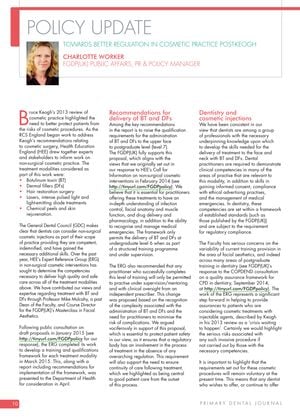Towards Better Regulation in Cosmetic Practice Post-Keogh
May 2015
in “
Primary Dental Journal
”

TLDR The conclusion is that improved training and oversight for cosmetic procedures are recommended to better protect patients.
In 2013, Bruce Keogh's review called for improved patient protection in cosmetic procedures, leading to the development of a training and qualifications framework for treatments like botulinum toxin (BT), dermal fillers (DFs), and hair restoration surgery. The General Dental Council (GDC) stated that dentists could perform non-surgical cosmetic injections within their scope of practice if competent and properly trained. Health Education England's Expert Reference Group (ERG) recommended raising the qualification requirements for administering BT and DFs to postgraduate level and that practitioners should only practice under supervision with clinical oversight from an independent prescriber. The Faculty of General Dental Practice (UK) (FGDP(UK)) supported these recommendations, emphasizing the importance of in-depth knowledge and the ability to manage medical emergencies. The ERG's proposals, completed in March 2015, were voluntary, but it was suggested that they become the industry standard. The FGDP(UK) expressed concerns about the variability in training for facial aesthetics and is working to align its Masterclass in Facial Aesthetics with the new framework. The document acknowledges that further work is needed to fully protect patients as outlined in Keogh's review, including establishing a national body for accreditation, improving adverse event reporting, and addressing the regulation of DFs. Existing practitioners were encouraged to meet the new standards by September 2018. The Keogh review is seen as having a significant impact on the regulation of cosmetic treatments.




